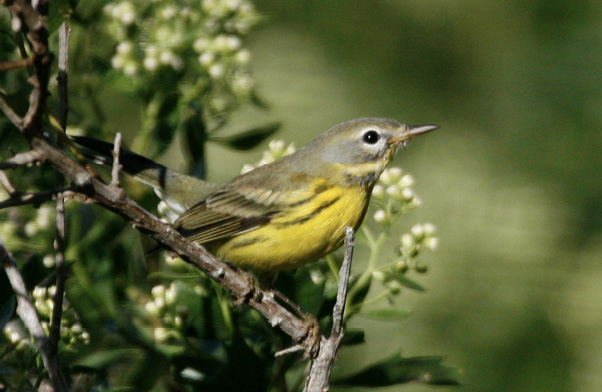Wayne R. Petersen

WAYNE R. PETERSEN
This issue’s mystery species is obviously a tiny bird, a fact suggested by its fine pointed bill, slender legs, and size compared to the twigs and blossoms also visible in the picture. When the picture is viewed online, the bird’s bright yellow underparts clearly suggest that the bird is probably a wood warbler of some sort, and few other tiny, pointy-billed birds are as prominently streaked on the breast as the mystery species. Among the alternative possibilities might be such petite species as wrens, kinglets, and gnatcatchers; however, all of these birds are plain breasted and none of them exhibits prominent yellow underparts.
Knowing that the mystery bird is a wood warbler at once narrows the field, and the presence of conspicuous streaks on the bird’s sides, but not on its breast, is an important clue. When combined with the distinct dark spot on the side of the bird’s lower neck, noticeable stripe over its eye, and obvious wing bars, the identification is readily clinched as a Prairie Warbler (Setophaga discolor). Although various other wood warblers are streaked below—e.g., Magnolia, Cape May, Palm—in these species the breast streaks extend across the midbreast and are in some cases less prominent than those exhibited by the mystery bird. Plus, all the other species fail to show the dark spot on the lower neck that is present in the Prairie Warbler and is obvious on the mystery warbler. The light gray face and nape are also frequently characteristic of this species in autumn.
Prairie Warblers are locally common summer residents in early successional habitats throughout Massachusetts, although they are most abundant in the pine barrens of southeastern Massachusetts and Cape Cod. They also frequent powerline corridors where habitat conditions are appropriate. Although locally common as breeders, as spring and fall migrants they tend not to be as widespread as many other wood warbler species. Rarely Prairie Warblers will linger in Massachusetts until early winter, most often on Cape Cod.
The author photographed this Prairie Warbler during fall migration at Pochet Island in East Orleans, Barnstable County, September 10, 2010.
Wayne R. Petersen